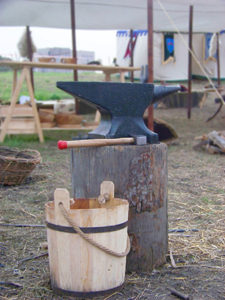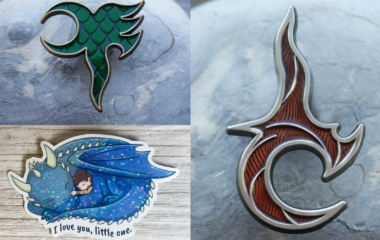
Personally, I find metalworking to be extremely rewarding, but like all things, it takes time and effort to become truly good at it. I’ve never made anything even remotely as good as Brisingr or Zar’roc, nor do I think I ever will. At least not with metal. My skill lies more with the keyboard and the brush than with the hammer and file. Still, I’ve thoroughly enjoyed the hours I’ve spent shaping metal.
Making a sword from scratch is incredibly difficult. Back in the day, a whole team of artists would be responsible for each sword. The smith would forge the blade, a jeweler or artisan would construct the furniture for the sword, and a woodworker/leatherworker would make the scabbard. That said, you can make short blades, like knives, extremely cheaply. The easiest way is by getting a piece of high-quality scrap steel and grinding it into shape by hand with files. I’ve done this, and it works pretty well.
The Modern Blacksmith, by Alexander G. Weygers, will give you a good understanding of the craft. I also recommend doing some reading at this link: http://www.anvilfire.com/21centbs/armor/index.htm
I did a lot of research before writing the scene in Brisingr where the elf Rhunön helps Eragon forge his own sword. If you are interesting in learning more, I recommend The Art of the Japanese Sword: As Taught by the Experts, by Kunihira Kawachi. Unfortunately, the book is out of print, but you may be able to borrow a copy via your local library’s interlibrary loan service.
Now if you’re serious about learning how to fight with a sword (or swords, since one is never enough!), I highly recommend you look into joining your local chapter of the Society for Creative Anachronism. The SCA is filled with people who are highly skilled with blade, bow, and every other kind of ancient weapon. In fact, they’re rather famous for staging not only jousts but full-on battles involving hundreds and sometimes thousands of people!
Growing up, my sister and I had lots of fun banging on each other with sticks and (later) Olympic fencing sabers. We didn’t have masks, and we rarely used gloves, which resulted in more than a few cuts and bruises. But it was totally worth it. I can’t say we learned much in the way of technique, but we did learn the tactical advantage of attacking first and making your opponent flinch. If you can do either of those two things, you’ll probably win.
I’ve gotten to cross swords with professionals on three different occasions. One was with a team of stage fencers who put on a show during the annual Steinbeck festival (which I had the opportunity to headline that year). Afterward, I got to cross blades with them in a friendly fashion. It was almost more fun than the festival itself!
The second and third times occurred in the same place: Kansas City, Missouri. I ended up there during my tours for Brisingr and Inheritance. Both times the local booksellers who coordinated the event arranged for a local fencing school to put on an exhibition with broadsword, rapier, saber, and foil before my talk. Imagine my delight, when, at each talk, I got to out on stage, all dressed up in a mask and fencing jacket, and go through a few basic moves with the master instructor. The first time I did manage to spin his sword out of his hand and disarm him (although I suspect he may have allowed me that in the spirit of putting on a good show), and the second time, he gave me a few friendly taps as we demonstrated the classic ‘iron triangle’ of sword fighting. It was definitely one of the most fun experiences on tour, and one I’d like to repeat. That said, I hope I never get into a swordfight for real; without lots of practice and some good armor, it’s almost certain that you’re going to get badly hurt.
I suppose that why, these days, I spend more time on the mail hauberk I’m making. That and the shirt of scale armor. Sheesh, I guess I’m never going to give up metalworking!




